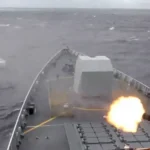
The incident in Rostov follows the trend of low altitude air strikes, affecting civilians and highlighting the fragility of urban areas in conflict zones
Rostov-On-Don, in southern Russia, was hit by a Ukrainian drone attack on Thursday, leaving thirteen people injured, local authorities. The action caused damage to residential buildings and generated concern among residents of the city.
The acting governor of the Rostov region, Yury Slyusus, detailed the situation on his channel on Telegram, stating that “Two of the injured were taken to local medical institutions and were in serious condition”. Another 11 affected “They are being taken to the hospital. Information about the victims will be updated”completed the governor, without providing immediate details about the identity of the injured.
Also read:
China-Camboja cooperation challenges logic of western power
Houthis defy Israel with hypersonic missile
Namibia faces the shadow of inequality
Material damage and impact on the population
According to Slyusus, the attack caused significant damage to various apartment buildings in Rostov, leaving residents concerned with safety in the region. There is still no information on whether the buildings have suffered structural impairment or if there was a need for residence evacuation.
The incident occurs amid a series of recent actions involving drones in the conflict between Russia and Ukraine, showing that urban areas remain vulnerable to low altitude air strikes capable of causing both civil wounds and material damage.
New incident in Belgorod
On the same Thursday, another attack with Ukrainian drone was recorded in the Belgorod region of Russia. According to preliminary reports, the drone would have hit a government building, causing “Small damage” No injured. The episode reinforces the trend of attacks limited to administrative and strategic areas, focusing on causing inconvenience and pressing local authorities.
Increasing tension on the border
The regions of Rostov and Belgorod, near the border with Ukraine, have been frequent points of Ukrainian attacks with drones and short -range missiles. Russian authorities have intensified air surveillance and security protocols, while residents are apprehensive at the possibility of new incidents.
Thursday’s attack illustrates how the war continues to reach not only military areas, but also cities inhabited by civilians, bringing direct risks to the population and reinforcing the fragility of urban areas in conflict zones.
Continuity of Russian attacks
While global attention turns to diplomatic negotiations, the Russian army kept its offensive. On Saturday, Russian forces took the village of Yablunivka, in the eastern region of Donetsk. Between 7 and 13 August, about 535 drones and Russian missiles hit Ukraine, of which less than two thirds were intercepted by the Ukrainian defenses. The Russian military command also launched eight missiles, five of which crossed the Ukrainian defense.
Ukrainian chief commander Oleksandr Syrskii said that despite the heavy losses of 33,000 Russian soldiers last month, the enemy has been able to recruit more effective than loses. “Therefore, we have no choice but to continue mobilization measures, improve combat training and reinforce the drone component of our troops.”he said. Russia plans to form 10 new divisions by the end of the year, two already in operation.
Highlighted diplomacy: the summit of Alaska
Amid military climbing, the announcement that Putin would meet Trump in Alaska generated a wave of diplomatic tension. Ukraine and its European allies were not invited, causing criticism. Ukrainian President Volodymyr Zelenskyy warned that Putin You are not serious about peacenoting that the Russian troops remain offensive: “There is no indication that Russians have received signs to prepare for a postwar situation. On the contrary, they are redistributing their troops and forces in ways that suggest preparations for new offensive operations.”
European leaders also expressed concern. Kaja Kallas, head of foreign policy of the European Union, emphasized: “Until Russia agree with a total and unconditional ceasefire, we should not even discuss any concessions.” The coalition of the disposed, a military group formed by major European armies, said that “International borders should not be changed by force” and defended additional sanctions if Moscow does not accept an immediate ceasefire.
Possible concessions and Ukrainian position
While some sources suggest that Ukraine could consider territorial concessions, Zelenskyy has publicly rejected any agreement that implies giving land. He stressed that in July alone, Russia launched more than 5,100 guided air pumps, 3,800 drones and almost 260 missiles. Ukraine has presented to the US authorities a plan with mutual concessions and NATO adherence to the remaining territories of the country, but without giving up strategic regions such as Donetsk, Luhansk, Zaporizehzia and Kherson.
The Institute for the Study of War (ISW) points out that giving in the still part of Donetsk would weaken Ukraine’s defensive capacity, as the region is home to “Fortaleza belt” Formed by fortified cities such as Sloviansk, Kramatorsk, Druzhivka and KonstyAntynivka, whose control represents years of military effort.
Ukrainian counter-attack
Ukraine also continues to promote strategic attacks on Russian military infrastructure. Recently, the Ukraine Security Service (SBU) reported that an attack on fire in the Tartarian Republic, as well as causing explosions on an anti -aircraft missile base in AffiSky. Refineries in Sratov and the Republic of Komi would also have been hit.
A complex impasse
The Alaska summit should include individual conversations between Putin and Trump, followed by meetings with delegates and a joint press conference. Trump suggested the possibility of exchange of territories, affirming “There will be some land exchange happening”while Zelenskyy reaffirms that Ukraine “It will not allow this second attempt to divide the country”.
The current scenario shows that while diplomatic efforts try to seek solutions, the conflict follows with intense military activity, continuous attacks and great risk to civilians in border regions. The tension between Russian offensive and Ukrainian resistance, combined with complex international diplomacy, keeps the world on alert for the next consequences of the conflict.
With information from news agencies Xinhua and Al Jazeera*
Source: https://www.ocafezinho.com/2025/08/14/drone-ucraniano-fere-13-civis-no-sul-da-russia/

